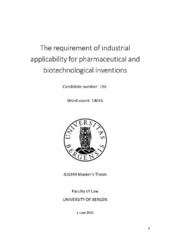| dc.description.abstract | An examination of the requirement of industrial applicability for pharmaceutical and biotechnological inventions, focusing on interpretation of Article 57 EPC in EPO BoA. Showing that the requirement is not interpreted literally, and that there perhaps is set a higher threshold for inventions in this area. The term "industry" should be interpreted in a wide sense to include all forms of industrial activity that are carried out continuously, independently and for financial (commercial) gains". There is not, however, an absolute need for potential financial return, as it should be understood to mean that an invention must have a beneficial use, constituting a concrete benefit to society, not just economic profit for the applicant. It is thus not sufficient that an invention can be reproduced. Results from computer-assisted in silico experiments are permitted as evidence to support purported industrial applications, and it is not absolutely necessary to provide evidence from wet-lab tests. The probative value" of in silico evidence must, however, be evaluated on a case-by- case basis. This means taking into account the nature of the invention (such as the complexity of the biological processes the invention is thought to affect, or the general importance of the discovery itself) and the prior art. There must be a clear correlation between gene sequence, protein structure and function on the molecular, cellular or biological level, though it is sufficient that a plausible function at one of these levels is disclosed. If the purported functions are based on homology with other substances, a high degree of homology is required. Evidence submitted after the filing date can be taken into account, but such evidence must support what has been disclosed in the application as it is filed. A patent cannot be granted solely based on post- published evidence. | en_US |
